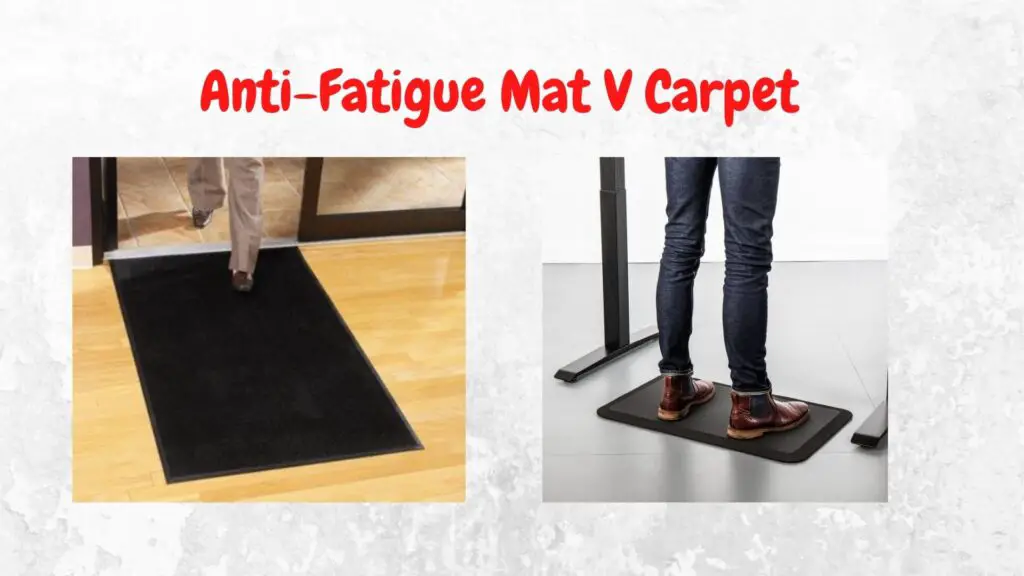If you’re starting to feel the effects of standing on your feet, you might want to consider the benefits of an anti-fatigue mat V carpet. This article evaluates each based on 9 key factors to determine which is the better of the 2. Stay tuned to find out which is best for you!
If you’re in a hurry, here is a site I recommended for office equipment with lifetime guarantee!
Anti-Fatigue Mat V Carpet
| Feature | Anti-fatigue mat | Carpet |
| Level of support | High | Low |
| Cost | $4 – $185+ | $12.99 – $3660 |
| Durability | High, suitable for work environments | Low, suitable for limited standing |
| Weight capacity | 300 pounds | None |
| Safety features | Multiple | Few |
| Thickness | 0.375 – 1.25 inches + | 0.375 – 0.44 inches |
| Material | Multiple | Multiple |
| Size | Small, medium, large | Small, medium, large |
| Style | Limited functional design | Variety of styles, shapes and colors |
Fatigue can occur when standing despite wearing high quality footwear. Source

Level of support
Anti-fatigue mats are designed to offer a high level of cushioning and shock absorption to allow you to stand for longer periods with less fatigue and discomfort.
Carpets on the other hand, are often thin and lack the cushioning material that gives anti-fatigue mats that fatigue-reducing capability.
Carpets may be ok if are standing for short periods and you don’t experience any discomfort to date. But in the long run, a standing mat will help to offset the effects of standing on your feet.
Cost
Anti-fatigue mats have a price range between $4 – $185+. In comparison, a carpet can start anywhere from $12.99 and reach prices as high as $3660+.
The majority of the time, it will be cheaper to opt for a carpet instead of a standing mat.
However, this financial saving could come at a cost to your health, so you’ll have to decide are anti-fatigue mats worth it!
As you know, carpets fail to offer the same level of cushioning and support as an anti-fatigue mat.
Therefore, if you do need more support than a carpet can offer, you might suffer from fatigue, discomfort, muscle soreness, varicose veins to name but a few.
Durability
Anti-fatigue mats are designed to different levels of durability. It tends to be based on the duration that the anti-fatigue mat will be used for. This means that they should be suitable for places where they will be used even for long hours throughout the day.
| Type of anti-fatigue mat | Duration of use | Environment suited to |
| Light duty | < 4 hours a day | Office, reception |
| Medium duty | 4 – 6 hours a day | Kitchen, office |
| Heavy duty | > 6 hours a day | Kitchen, workshop, assembly line, outdoors |
The fatigue-reducing mat should return to its original shape quickly as you shift your weight off it.
This is an important consideration when choosing a quality anti-fatigue mat.
Fatigue-reducing mats can also be resistant to spills, stains, hot objects and punctures.
In general, anti-fatigue mats have a lifespan of approximately 2 years.
However, if you opt for the Safco Movable Anti-Fatigue Mat, you can get a lifetime warranty.
In contrast, carpets have a lifespan of 5 – 15 years. They are not really designed for being stood on.
Therefore, choosing a durable carpet becomes more difficult as they don’t tend to be sold based on their durability.
That said, if you do require a more durable carpet, opt for one that is denser as opposed to thick.
You can also consider carpet wear warranties of at least 5 – 10 years. However, the carpet warranties often have caveats which don’t cover day to day wear and tear.
What’s even more effective is the standard that carpets are designed for.
The European standard (EN 1307) or the American standard (General Conformity Certificate – GCC) should be checked before purchase. This will confirm that the carpet or rug has met the necessary safety and quality standards for where it will be used.
Tip: Pay close attention to what’s covered in carpet wear warranties as not all wear and tear is covered.
Weight capacity
When purchasing an anti-fatigue mat, you’ll notice that there is a weight limit provided. This indicates how much pressure the standing mat can withstand without becoming subject to sinking or damage.
Anti-fatigue mats can hold weights as high as about 300 pounds.
On the other hand, I have never seen carpets to come with a weight limit.
They don’t need one anyway, because they don’t offer the same cushioning and so are not liable to sinking the way an anti-fatigue mat would.
Safety features
Anti-fatigue mats are designed for a range of work environments including:
- Homes
- Offices
- Kitchens
- Workshops
- Electrical workplaces
- Labs
- Cleanrooms
- Outdoors
To accommodate such environments, you can choose the safety features of the anti-fatigue mats based on the environmental conditions it will need to withstand.
Safety features that industrial anti-fatigue mats have include:
- Anti-slip
- Chemical resistant
- Drainage built in
- Fire resistant
- Oil resistant
- Anti-static
With a carpet, there will be little to no selectable safety features. This might be ok if you only need some light cushioning when you stand at your office desk.
But be warned that the carpet should at a minimum not pose a trip hazard or slide while you stand on it.
Thickness
Anti-fatigue mats come in an array of thickness levels, starting from 0.375 inches and ranging as thick as 1.25 inches +.
The extra padding offers you a greater level of cushioning. However, choosing too much could make using the standing mat a bit of a balancing act.
With carpets, they range from thin to thick, but on a far smaller scale than standing mats.
The average thickness of a household carpet is between 0.375 – 0.44 inches thick.
Plus, the material that carpets are made of makes them liable to sinking under your weight, whereas anti-fatigue mats are designed to be durable to this pressure.
Material
Both standing mats and carpets have an array of materials to choose from.
Anti-fatigue mats are generally made from polyurethane foam, gel, vinyl or rubber which are durable materials with cushioning properties.
High density memory foam is a popular choice for anti-fatigue mats.
Carpets are made from a variety of materials including:
- acrylic
- nylon
- polyester
- polypropylene
- Silk
- wool
Tip: Nylon is one of the most durable carpet types available.
Size
Standing mats are available in compact sizes suitable for standing one person on. Small sizes start around 17 x 24 inches while larger standing mats measure in around 24 x 70 inches.
They can range all the way up to rolls which are suited to workshops or more industrial environments.
Carpets are also available in small, medium and large sizes.
They also tend to come in a greater variety of shapes, whereas anti-fatigue mats tend to be only square or rectangular.
Style
Anti-fatigue mats tend to be designed with functionality and safety in mind. They are generally sold in a black color and have limited aesthetic features, especially industrial anti-fatigue mats.
Carpets are the leaders on the style front.
One of the primary functions of a carpet is to enhance the aesthetics of a room along with warmth and softness.
Do anti-fatigue mats work on carpet?
Fatigue-reducing mats can still be used and provide even greater support, even if it is placed on a carpet. It should be confirmed that the carpet underneath won’t interfere with the standing mat or cause it to slip or move while it is in use.
If it does tend to slip on the carpet, a non-slip rubber backing should be obtained to prevent this from occurring.
Related: Balance boards vs anti-fatigue mat – cheat sheet included
Conclusion
As you can see, the anti-fatigue mats triumph over carpets in practically every feature.
Standing mats are without a doubt more effective than carpet at providing comfort and support while you stand.
However, if very light cushioning, aesthetics and coziness are your key priorities, then a carpet might just do the job!
If you’re still not sure or would like further dive into the many benefits of anti-fatigue mats, I have written some articles worth a look.
Here are some other useful articles I wrote that you should go check out:
- How Much Do Anti-fatigue Mats Cost? – A Complete Guide!
- How do anti-fatigue mats work? With FAQs
- How to choose an anti-fatigue mat – 16 essential factors
- How to maintain anti-fatigue mats – 12 easy tips
- 7 Anti-fatigue Mat FAQs – Surprising & Helpful Answers!
Recommended products:
